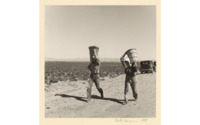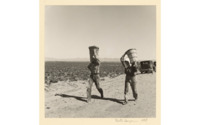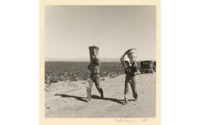-
 Farm Workers, South of Tracy, California
Farm Workers, South of Tracy, California Two farm workers, a couple, carry produce on their shoulders in the hot California sun. The weight of their produce was then used to determine their payment as part of the migrant worker program. The Farm Security Administration commissioned Dorothea Lange in 1938 to visit such farms in Arizona, New Mexico, Texas, Oklahoma, Arkansas, Mississippi, Georgia, Missouri, and California. Lange used her photography to advocate for better working conditions for migrant workers after witnessing their plight in the workers’ camps.
-
 Pesticides Kill Farmworkers—1990
Pesticides Kill Farmworkers—1990 Cesar Chavez, a leader of the United Farmworkers Movement, discusses the health concerns of using the pesticide DDT in the fields. Chavez details the boycott of 1965 which urged grape growers to eliminate their use of pesticides because of farmworkers who developed cancer, experienced birth defects, and other health issues after exposure to DDT. He also explores the emergence of cancer clusters due to pesticide use in vineyards and other agricultural sites in the Silicon Valley of California. Chavez recounts the success of the 1965 boycott and uses it as motivation for farmworkers in the 1990s to take up the fight against another deadly pesticide, organophosphates.
-
 Pesticides Kill Farmworkers—1990
Pesticides Kill Farmworkers—1990 Cesar Chavez, a leader of the United Farmworkers Movement, discusses the health concerns of using the pesticide DDT in the fields. Chavez details the boycott of 1965 which urged grape growers to eliminate their use of pesticides because of farmworkers who developed cancer, experienced birth defects, and other health issues after exposure to DDT. He also explores the emergence of cancer clusters due to pesticide use in vineyards and other agricultural sites in the Silicon Valley of California. Chavez recounts the success of the 1965 boycott and uses it as motivation for farmworkers in the 1990s to take up the fight against another deadly pesticide, organophosphates.
-
 Pesticides Kill Farmworkers—1990
Pesticides Kill Farmworkers—1990 Cesar Chavez, a leader of the United Farmworkers Movement, discusses the health concerns of using the pesticide DDT in the fields. Chavez details the boycott of 1965 which urged grape growers to eliminate their use of pesticides because of farmworkers who developed cancer, experienced birth defects, and other health issues after exposure to DDT. He also explores the emergence of cancer clusters due to pesticide use in vineyards and other agricultural sites in the Silicon Valley of California. Chavez recounts the success of the 1965 boycott and uses it as motivation for farmworkers in the 1990s to take up the fight against another deadly pesticide, organophosphates.
-
 Paul Taylor with Migrant Workers, Imperial Valley, California
Paul Taylor with Migrant Workers, Imperial Valley, California Dorothea Lange’s husband, Paul Taylor, stands with a family of migrant farm workers in California. Taylor was a professor of economics and became interested in the plight of Mexican migrant workers after receiving his PhD in Labor Economics from the University of California, Berkeley in 1922. Lange took this photograph early in her relationship with Taylor during a trip in 1935 to document the lives of farm workers throughout California. It displays the poor living conditions of workers who toiled in the fields for very little money. The couple used photography to highlight the struggles that migrant workers faced and encourage political action to improve their living conditions.
-
 Farm Workers, South of Tracy, California
Farm Workers, South of Tracy, California Two farm workers, a couple, carry produce on their shoulders in the hot California sun. The weight of their produce was then used to determine their payment as part of the migrant worker program. The Farm Security Administration commissioned Dorothea Lange in 1938 to visit such farms in Arizona, New Mexico, Texas, Oklahoma, Arkansas, Mississippi, Georgia, Missouri, and California. Lange used her photography to advocate for better working conditions for migrant workers after witnessing their plight in the workers’ camps.
-
 Farm Workers, South of Tracy, California
Farm Workers, South of Tracy, California Two farm workers, a couple, carry produce on their shoulders in the hot California sun. The weight of their produce was then used to determine their payment as part of the migrant worker program. The Farm Security Administration commissioned Dorothea Lange in 1938 to visit such farms in Arizona, New Mexico, Texas, Oklahoma, Arkansas, Mississippi, Georgia, Missouri, and California. Lange used her photography to advocate for better working conditions for migrant workers after witnessing their plight in the workers’ camps.
-
[Untitled]
 Farm Workers, South of Tracy, California Two farm workers, a couple, carry produce on their shoulders in the hot California sun. The weight of their produce was then used to determine their payment as part of the migrant worker program. The Farm Security Administration commissioned Dorothea Lange in 1938 to visit such farms in Arizona, New Mexico, Texas, Oklahoma, Arkansas, Mississippi, Georgia, Missouri, and California. Lange used her photography to advocate for better working conditions for migrant workers after witnessing their plight in the workers’ camps.
Farm Workers, South of Tracy, California Two farm workers, a couple, carry produce on their shoulders in the hot California sun. The weight of their produce was then used to determine their payment as part of the migrant worker program. The Farm Security Administration commissioned Dorothea Lange in 1938 to visit such farms in Arizona, New Mexico, Texas, Oklahoma, Arkansas, Mississippi, Georgia, Missouri, and California. Lange used her photography to advocate for better working conditions for migrant workers after witnessing their plight in the workers’ camps. Pesticides Kill Farmworkers—1990 Cesar Chavez, a leader of the United Farmworkers Movement, discusses the health concerns of using the pesticide DDT in the fields. Chavez details the boycott of 1965 which urged grape growers to eliminate their use of pesticides because of farmworkers who developed cancer, experienced birth defects, and other health issues after exposure to DDT. He also explores the emergence of cancer clusters due to pesticide use in vineyards and other agricultural sites in the Silicon Valley of California. Chavez recounts the success of the 1965 boycott and uses it as motivation for farmworkers in the 1990s to take up the fight against another deadly pesticide, organophosphates.
Pesticides Kill Farmworkers—1990 Cesar Chavez, a leader of the United Farmworkers Movement, discusses the health concerns of using the pesticide DDT in the fields. Chavez details the boycott of 1965 which urged grape growers to eliminate their use of pesticides because of farmworkers who developed cancer, experienced birth defects, and other health issues after exposure to DDT. He also explores the emergence of cancer clusters due to pesticide use in vineyards and other agricultural sites in the Silicon Valley of California. Chavez recounts the success of the 1965 boycott and uses it as motivation for farmworkers in the 1990s to take up the fight against another deadly pesticide, organophosphates. Pesticides Kill Farmworkers—1990 Cesar Chavez, a leader of the United Farmworkers Movement, discusses the health concerns of using the pesticide DDT in the fields. Chavez details the boycott of 1965 which urged grape growers to eliminate their use of pesticides because of farmworkers who developed cancer, experienced birth defects, and other health issues after exposure to DDT. He also explores the emergence of cancer clusters due to pesticide use in vineyards and other agricultural sites in the Silicon Valley of California. Chavez recounts the success of the 1965 boycott and uses it as motivation for farmworkers in the 1990s to take up the fight against another deadly pesticide, organophosphates.
Pesticides Kill Farmworkers—1990 Cesar Chavez, a leader of the United Farmworkers Movement, discusses the health concerns of using the pesticide DDT in the fields. Chavez details the boycott of 1965 which urged grape growers to eliminate their use of pesticides because of farmworkers who developed cancer, experienced birth defects, and other health issues after exposure to DDT. He also explores the emergence of cancer clusters due to pesticide use in vineyards and other agricultural sites in the Silicon Valley of California. Chavez recounts the success of the 1965 boycott and uses it as motivation for farmworkers in the 1990s to take up the fight against another deadly pesticide, organophosphates. Pesticides Kill Farmworkers—1990 Cesar Chavez, a leader of the United Farmworkers Movement, discusses the health concerns of using the pesticide DDT in the fields. Chavez details the boycott of 1965 which urged grape growers to eliminate their use of pesticides because of farmworkers who developed cancer, experienced birth defects, and other health issues after exposure to DDT. He also explores the emergence of cancer clusters due to pesticide use in vineyards and other agricultural sites in the Silicon Valley of California. Chavez recounts the success of the 1965 boycott and uses it as motivation for farmworkers in the 1990s to take up the fight against another deadly pesticide, organophosphates.
Pesticides Kill Farmworkers—1990 Cesar Chavez, a leader of the United Farmworkers Movement, discusses the health concerns of using the pesticide DDT in the fields. Chavez details the boycott of 1965 which urged grape growers to eliminate their use of pesticides because of farmworkers who developed cancer, experienced birth defects, and other health issues after exposure to DDT. He also explores the emergence of cancer clusters due to pesticide use in vineyards and other agricultural sites in the Silicon Valley of California. Chavez recounts the success of the 1965 boycott and uses it as motivation for farmworkers in the 1990s to take up the fight against another deadly pesticide, organophosphates. Paul Taylor with Migrant Workers, Imperial Valley, California Dorothea Lange’s husband, Paul Taylor, stands with a family of migrant farm workers in California. Taylor was a professor of economics and became interested in the plight of Mexican migrant workers after receiving his PhD in Labor Economics from the University of California, Berkeley in 1922. Lange took this photograph early in her relationship with Taylor during a trip in 1935 to document the lives of farm workers throughout California. It displays the poor living conditions of workers who toiled in the fields for very little money. The couple used photography to highlight the struggles that migrant workers faced and encourage political action to improve their living conditions.
Paul Taylor with Migrant Workers, Imperial Valley, California Dorothea Lange’s husband, Paul Taylor, stands with a family of migrant farm workers in California. Taylor was a professor of economics and became interested in the plight of Mexican migrant workers after receiving his PhD in Labor Economics from the University of California, Berkeley in 1922. Lange took this photograph early in her relationship with Taylor during a trip in 1935 to document the lives of farm workers throughout California. It displays the poor living conditions of workers who toiled in the fields for very little money. The couple used photography to highlight the struggles that migrant workers faced and encourage political action to improve their living conditions. Farm Workers, South of Tracy, California Two farm workers, a couple, carry produce on their shoulders in the hot California sun. The weight of their produce was then used to determine their payment as part of the migrant worker program. The Farm Security Administration commissioned Dorothea Lange in 1938 to visit such farms in Arizona, New Mexico, Texas, Oklahoma, Arkansas, Mississippi, Georgia, Missouri, and California. Lange used her photography to advocate for better working conditions for migrant workers after witnessing their plight in the workers’ camps.
Farm Workers, South of Tracy, California Two farm workers, a couple, carry produce on their shoulders in the hot California sun. The weight of their produce was then used to determine their payment as part of the migrant worker program. The Farm Security Administration commissioned Dorothea Lange in 1938 to visit such farms in Arizona, New Mexico, Texas, Oklahoma, Arkansas, Mississippi, Georgia, Missouri, and California. Lange used her photography to advocate for better working conditions for migrant workers after witnessing their plight in the workers’ camps. Farm Workers, South of Tracy, California Two farm workers, a couple, carry produce on their shoulders in the hot California sun. The weight of their produce was then used to determine their payment as part of the migrant worker program. The Farm Security Administration commissioned Dorothea Lange in 1938 to visit such farms in Arizona, New Mexico, Texas, Oklahoma, Arkansas, Mississippi, Georgia, Missouri, and California. Lange used her photography to advocate for better working conditions for migrant workers after witnessing their plight in the workers’ camps.
Farm Workers, South of Tracy, California Two farm workers, a couple, carry produce on their shoulders in the hot California sun. The weight of their produce was then used to determine their payment as part of the migrant worker program. The Farm Security Administration commissioned Dorothea Lange in 1938 to visit such farms in Arizona, New Mexico, Texas, Oklahoma, Arkansas, Mississippi, Georgia, Missouri, and California. Lange used her photography to advocate for better working conditions for migrant workers after witnessing their plight in the workers’ camps.